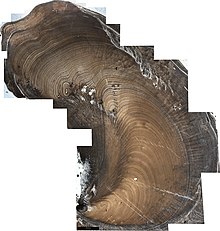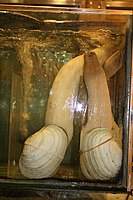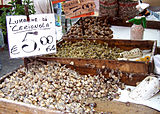Geoduck
| Geoduck | |
|---|---|

| |
| A live specimen of Panopea generosa | |
| Scientific classification | |
| Domain: | Eukaryota |
| Kingdom: | Animalia |
| Phylum: | Mollusca |
| Class: | Bivalvia |
| Order: | Adapedonta |
| Family: | Hiatellidae |
| Genus: | Panopea |
| Species: | P. generosa
|
| Binomial name | |
| Panopea generosa Gould, 1850
| |
The Pacific geoduck (/ˈɡuːiˌdʌk/ GOO-ee-duk; Panopea generosa) is a species of very large saltwater clam in the family Hiatellidae.[1][2] The common name is derived from the Lushootseed name, gʷidəq.
The geoduck is native to the coastal waters of the eastern North Pacific Ocean from Alaska to Baja California.[2] The shell of the clam ranges from 15 centimetres (6 in) to over 20 centimetres (8 in) in length, but the extremely long siphons make the clam itself much longer than this: the "neck" or siphons alone can be 1 metre (3 ft 3 in) in length. The geoduck is the largest burrowing clam in the world.[3] It is also one of the longest-living animals of any type, with a typical lifespan of 140 years;[4] the oldest has been recorded at 179 years old.[5] The precise longevity of geoducks can be determined from annual rings deposited in the shell which can be assigned to calendar years of formation through crossdating.[6][7] These annual rings also serve as an archive of past marine variability.[5][8][9]

Etymology

The name Geoduck is derived from the Lushootseed name for the animal, gʷidəq.[10] The etymology of gʷidəq is disputed. The lexical suffix =əq means "many" in Lushootseed.[10] The Oxford English Dictionary claims it is composed of a root word of unknown meaning and =əq instead meaning "genitals" (referring to the shape of the clam),[11][12] while other researchers claim it is a phrase meaning "dig deep".[13]
It is sometimes known as a mud duck, king clam or, when translated literally from Chinese, an elephant-trunk clam (Chinese: 象拔蚌; pinyin: xiàngbábàng; Jyutping: zoeng6 bat6 pong5).[14]
Between 1983 and 2010, the scientific name of this clam was confused with that of an extinct clam, Panopea abrupta (Conrad, 1849), in scientific literature.[2]
Biology
Native to the
A related species,
The oldest recorded specimen was 179 years old, but individuals usually live up to 140 years.
Geoducks are broadcast spawners. A female geoduck produces about 5
Biomass densities in Southeast Alaska are estimated by divers, then inflated by twenty percent to account for geoducks not visible at the time of survey.[18] This estimate is used to predict the two percent allowed for commercial harvesting.[18]
Industry
The world's first geoduck fishery was created in 1970, but demand for the half-forgotten clam was low at first due to its texture.[citation needed] As of 2011[update], these clams sell in China for over US$33 per kilogram or $15 per pound.[19][20]
The geoduck's high market value has created an $80-million industry, with harvesting occurring in the US states of
As of 2007[update], advances in the testing system for contaminated clams have allowed geoduck harvesters to deliver live clams more consistently. The new testing system determines the viability of clams from tested beds before the harvesters fish the area. Previous methods tested clams after harvest. This advancement has meant that 90 percent of clams were delivered live to market in 2007. In 2001, only 10 percent were live.[22] Because geoduck have a much higher market value live, an additional $4.4 to $6.6 per kilogram or $2 to $3 per pound, this development has helped to stimulate the burgeoning industry.
The COVID-19 pandemic disrupted the geoduck industry. Given the near-shutdown of restaurants and seafood markets across the country, demand for live geoducks plummeted. Divers in Southeast Alaska who typically see prices of $11 to $22 per kilogram or $5 to $10 per pound for live geoducks reported prices as low as $2.2 per kilogram or $1 per pound, leading many to stop fishing temporarily.[23]
-
Seafood geoduck display in a Chinese restaurant in Hong Kong
-
An ostensibly record-setting geoduck, Ye Olde Curiosity Shop, Seattle, Washington.
Environmental impact
Geoduck farming grow-out and harvest practices are controversial,[24] and have created conflicts with shoreline property owners,[25][26][27][28] and concerns from nongovernmental organizations.[29] However, the Environmental Defense Fund has found that bivalves (oysters, mussels, and clams) are beneficial to the marine environment.[30] The water must be certifiably clean to plant geoducks commercially.[31] Regulation was mandated in 2007.[32][33] Studies have been funded to determine short- and long-term environmental and genetic impacts.[34] In southern Puget Sound, the effect of geoduck farming on large mobile animals is ambiguous.[35] A 2004 draft biological assessment, commissioned by three of the largest commercial shellfish companies in the Puget Sound region, identified no long-term effects of geoduck farming on threatened or endangered species.[36]
Culinary uses
The large, meaty siphon is prized for its
-
Geoduck before cooking at a Chinese restaurant in Sunnyvale
-
Cooked geoduck (right) at a Chinese restaurant in Sunnyvale
In popular culture
Evergreen State College in Olympia, Washington, has a geoduck as its mascot named Speedy.[37][38]
Geoducks have also earned some internet infamy due to the phallic appearance of their siphons.[39]
References
- ^ Panopea generosa Gould, 1850. Retrieved through: World Register of Marine Species on 28 December 2010.
- ^ S2CID 84189390. Retrieved 2 March 2012.
- ^ a b c Morgan, James (19 July 2015). "The 'phallic' clam America sells to China". BBC. Retrieved 20 July 2015.
- ^ doi:10.1139/f04-136.
- ^ S2CID 239151578. Retrieved 13 September 2022.
- .
- doi:10.1139/F08-158.
- .
- S2CID 15853307.
- ^ a b Bates, Dawn; Hess, Thom; Hilbert, Vi (1994). Lushootseed Dictionary. Seattle: University of Washington Press.
- ^ "geoduck". Oxford English Dictionary (Online ed.). Oxford University Press. (Subscription or participating institution membership required.)
- ^ "geoduck". Dictionary.com Unabridged (Online). n.d. Retrieved 29 March 2007.
- ^ Campbell, A.; Harbo, R. M.; Hand, C. M. (1998). "Harvesting and distribution of Pacific Geoduck Clams". Proceedings of the North Pacific Symposium on Invertebrate Stock Assessment and Management: 350.
- ISBN 978-0-19-103573-9.
- ^ "Geoduck Aquaculture Research Program" (PDF). wsg.washington.edu. Geoduck Aquaculture Research Program, Washington Sea Grant. Retrieved 18 April 2014.
- ^ Willner, Georgina B. (June 2006). The Potential Impacts of the Commercial Geoduck (Panope generosa) Hydraulic Harvest Method on Organisms in the Sediment and at the Water-Sediment Interface in Puget Sound (PDF) (Master thesis). Olympia, Washington: The Evergreen State College. Retrieved 1 January 2023.
- ^ Palazzi, David C.; Goodwin, Lynn; Bradbury, Alex; Sizemore, Bob; Washington (state) (23 May 2001). Espy, Leigh; Sturges, Susan; Ladenburg, Candis; Sabottke, Blanch (eds.). Final Supplemental Environmental Impact Statement: State of Washington Commercial Geoduck Fishery (PDF) (Report). Olympia WA: State of Washington Department of Natural Resources: Department of Fish and Wildlife. p. 5. Retrieved 1 January 2023.
- ^ a b Rumble, JM; Hebert, KP; Siddon, CE (2012). "Estimating Geoduck Harvest Rate and Show Factors in Southeast Alaska". In: Steller D, Lobel L, Eds. Diving for Science 2012. Proceedings of the American Academy of Underwater Sciences 31st Symposium. Archived from the original on 29 September 2013. Retrieved 29 September 2013.
{{cite journal}}: CS1 maint: unfit URL (link) - ^ Vedder, Tracy (3 March 2011). "Chinese mafia rakes in millions from 'Puget Sound gold'". KOMOnews.com. Archived from the original on 6 June 2011. Retrieved 6 March 2011.
- ^ Welch, Craig, 2012. NW geoducks fetch top dollar in China, and as prices soar, so do concerns about illegal harvesting in Puget Sound, The Seattle Times, 22 April 2012, pp 1 & 10.
- ^ Dunagan, Christopher. "Poaching hurts geoduck population growth". Kitsap Sun. Archived from the original on 29 February 2012. Retrieved 5 June 2012.
- ^ Ess, Charlie. "Toxin test gives live market a boost; quota also gets a significant bump". National Fisherman. Archived from the original on 14 November 2006. Retrieved 1 August 2008.
- ^ Stone, Eric; Ketchikan, Alaska's Energy Desk- (18 February 2020). "Coronavirus shutters Southeast Alaska geoduck clam fishery". Alaska Public Media. Retrieved 18 February 2020.
- ^ "Geoduck aquaculture in South Puget Sound" (PDF). Protectourshoreline.org. Retrieved 23 May 2017.
- ^ "Protect Our Shoreline". Protect Our Shoreline. 12 July 2000. Retrieved 5 June 2012.
- ^ "APHETI-Association to Protect Hammersley, Eld and Totten Inlets". Apheti.com. Archived from the original on 29 September 2007. Retrieved 5 June 2012.
- ^ "Responsible Shellfish Farming BC". Responsibleshellfishfarming.ca. Archived from the original on 18 February 2012. Retrieved 5 June 2012.
- ^ "Henderson Bay Shoreline Association". Archived from the original on 28 September 2007. Retrieved 20 May 2017.
- ^ "About the Partnership". Puget Sound Partnership. Archived from the original on 7 May 2009. Retrieved 8 May 2009.
- ^ Goldburg, Rebecca; et al. (2001). "Marine Aquaculture in the United States". Environmental Defense for Pew Oceans Commission.
- ^ "Commercial Shellfish Licensing & Certification Program". Washington State Department of Health Office of Shellfish and Water Protection. Archived from the original on 6 May 2009. Retrieved 8 May 2009.
- ^ "Shellfish Aquaculture Regulatory Committee". Washington State Department of Ecology. Archived from the original on 21 August 2007. Retrieved 10 December 2018.
- ^ Interim Progress Report: House Bill 2220 Shellfish Aquaculture Regulatory Committee (PDF) (Report). House Committee on Ecology and Parks House Committee on Agriculture and Natural Resources Senate Committee on Natural Resources, Ocean & Recreation. December 2007. Retrieved 1 January 2023.
- ^ "Current Geoduck Research". Washington Sea Grant. Archived from the original on 19 June 2012. Retrieved 5 June 2012.
- S2CID 2075387.
- ^ "Programmatic Biological Evaluation" (PDF). Protectourshoreline.org. Retrieved 23 May 2017.
- ^ "Speedy, Evergreen's Geoduck Mascot". evergreen.edu. Retrieved 20 September 2019.
- ^ "10 Weird And Hilarious College Mascots". buzzfeed.com. 11 November 2011. Retrieved 20 September 2019.
2. Evergreen State - The Geoduck
- ^ Tran, Lina (17 July 2016). "Everything You Need to Know About Geoducks". Eater. Retrieved 11 August 2022.
External links
- Man and Mollusc—Geoduck facts
- Geoduck.org; Underwater Harvester's Association
- Geoduck.org: UHA—BC Seafood Alliance,
- The Evergreen State College's Geoducks Page
- Fisheries and Oceans Canada—Geoduck clam (Panopea abrupta)—Anatomy, Histology, Development, Pathology, Parasites, and Symbionts.
- "Duckumentary" film Home Page: "3 Feet Under—Digging Deep for the Geoduck Clam"
- Geoduck cooking Recipes





